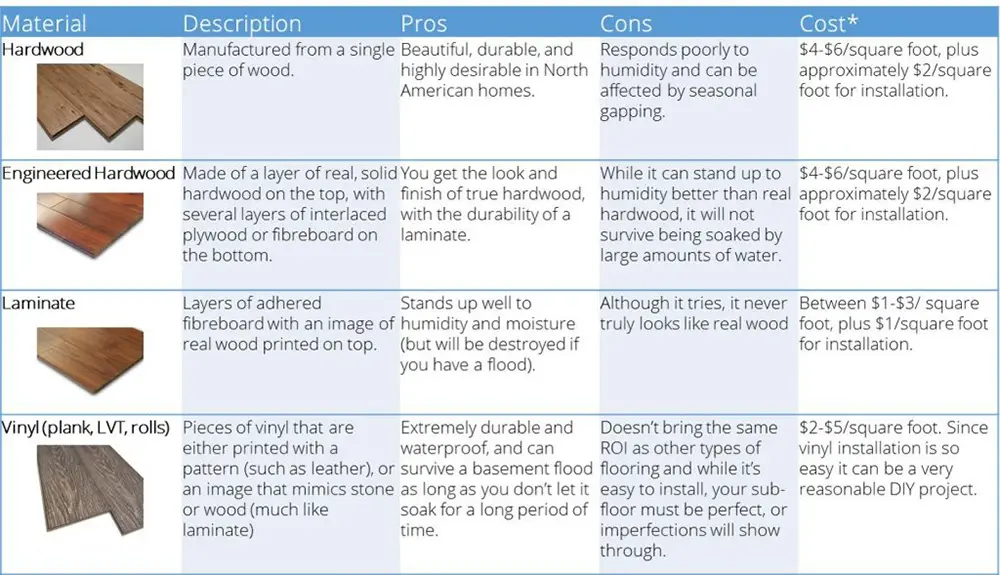Kitchen Sinks
“From handling greasy pans to washing muddy pets, your kitchen sink faces numerous challenges daily. That’s why we provide durable sinks designed for easy maintenance, available in an extensive range of materials, designs, and finishes.”
1- Ceramic sinks continue to be a sought-after option, cherished for their inviting appeal, and seamlessly complementing both modern and traditional kitchen designs. Our extensive selection of ceramic sinks ensures there’s a perfect fit for every space. (picture of ceramic sink)

2- Kitchen sinks endure significant wear and tear throughout their lifespan. Composite sinks, crafted from resilient stone and composite materials, provide exceptional durability and resistance to stains and heat, ensuring a long-lasting and reliable sink solution. (picture of composite sink)

3- Stainless steel sinks continue to be a top preference due to their durability, low maintenance requirements, and ability to enhance both functionality and aesthetics in any kitchen. Explore our diverse array of shapes and finishes to find the perfect match for your space. (picture of stainless-steel sink)

Kitchen Colors
1-Black kitchen:
With its inherent versatility, black seamlessly transitions between opulent accents and sleek modernity. Shades like Charcoal provide a sophisticated depth, offering a bold contrast that complements any array of accessories and appliances. For a truly striking statement, Sumi Black elevates your kitchen to new heights with its captivating finish, making a lasting impression.
2- Blue Kitchen
Discover the allure of blue kitchens, where contemporary flair meets enduring elegance. Vibrant Blue boasts rich pigments, infusing your kitchen with luxurious style and vibrancy.
For those seeking a kitchen with character, Navy Blue adds a touch of warmth, lending a unique and captivating edge to your space.
Blue, drawing inspiration from the depths of the ocean, exudes confidence and depth, inviting you on a journey of bold exploration in your kitchen design.
3- White Kitchen
A white kitchen serves as a pristine canvas for you to express your personal style. Whether you prefer a minimalist approach or love to adorn your space with accessories, our collection of white kitchens offers boundless possibilities.
With its sleek and sophisticated design, our White color options remain consistently sought-after. They effortlessly blend with our curated color palette, allowing you to create a distinctive two-tone kitchen ensemble.
4- Cream Kitchen
Exuding tranquility and understated elegance, a cream kitchen welcomes a sense of calm into the heart of your home. Our range of cream kitchens offers a cozy charm that adapts seamlessly to any style preference.
5- Grey Kitchen
Effortlessly adaptable, a grey kitchen offers a spectrum of possibilities, from striking to subdued, opulent to minimalist. Tailor your grey kitchen to your unique taste, utilizing shades like Stone Grey as a versatile foundation for vibrant accents or refined neutrals.
Explore the gentle allure of Light Grey and the bold sophistication of Dark Grey, crafting a cohesive palette or experimenting with eclectic combinations from our diverse range of hues.
Laundry / utility room Cabinets
An efficiently designed laundry room provides a functional environment for washing, folding, and organizing laundry, while also accommodating cleaning supplies. Here are some key features to consider:
- Ample counter space designated for folding clothes and linens.
- Utilize baskets and bins for effortless sorting of laundry.
- Cabinets and drawers provide tidy storage for detergent, bleach, cleaning supplies, and rags, keeping them neatly concealed.
- Incorporate pullout racks for storing linens and vertical shelf dividers for organizing cleaning supplies, mops, and brooms.
Kitchen hood types
Kitchen Hood Comparison: Microwave, Chimney, Under Cabinet, Downdraft, and Island Ceiling Mount
When selecting a kitchen hood, considering factors like hood type, fan noise, and CFM (cubic feet per minute) airflow is crucial. Let’s compare the different types:
- Microwave Hood:
– Type: Mounted above the stove, combining microwave functionality with ventilation.
– Fan Noise: Typically, quieter due to integrated microwave fan.
– CFM: Usually lower compared to dedicated ventilation hoods.
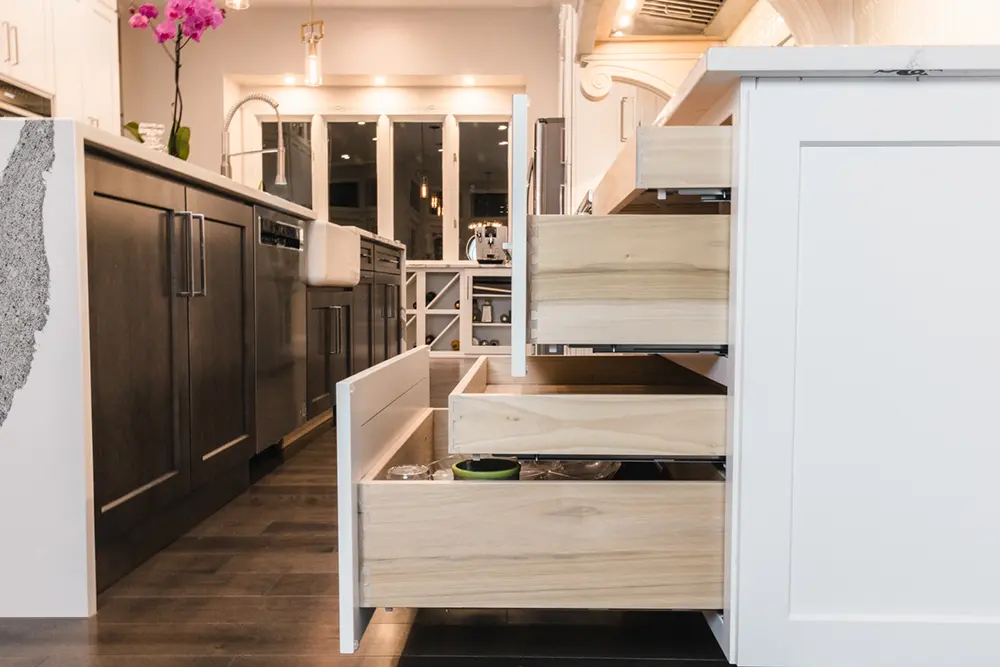
- Chimney Hood:
– Type: Mounted on the wall, featuring a chimney-like structure for ventilation.
– Fan Noise: Variable, depending on fan speed and motor quality.
– CFM: Typically higher, suitable for larger kitchens and high-heat cooking.
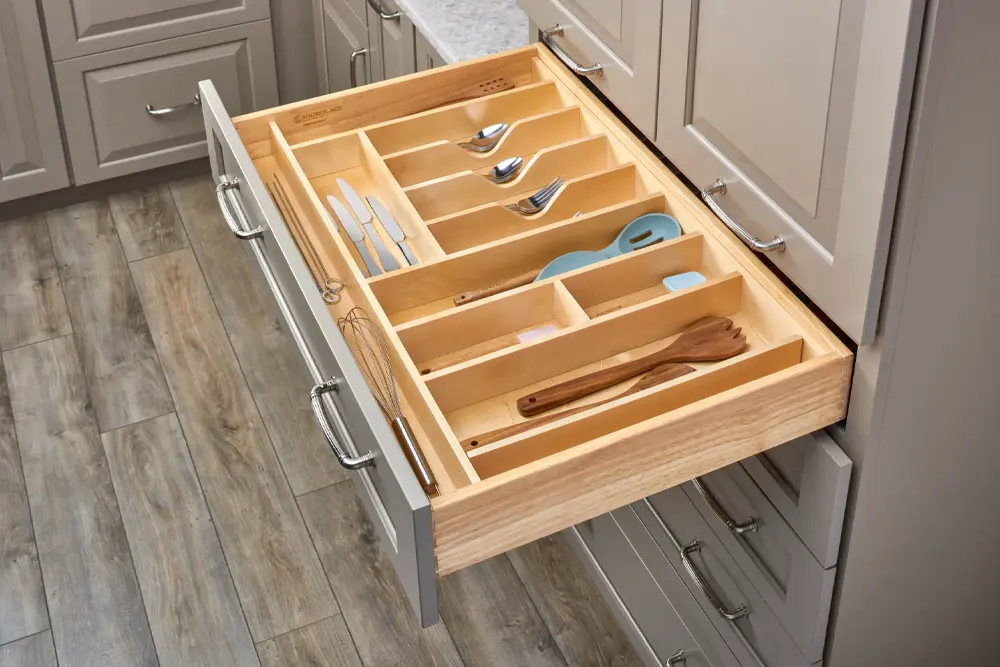
- Under Cabinet Hood:
– Type: Installed beneath the cabinets, saving space and providing effective ventilation.
– Fan Noise: Generally moderate, with noise levels varying based on fan quality.
– CFM: Moderate to high, depending on model and size.

- Downdraft Hood:
– Type: Rises from the countertop or cooktop when in use, retracting when not needed.
– Fan Noise: Can be louder due to compact design and powerful motor.
– CFM: Moderate to high but may be less effective in capturing smoke and odors compared to other types.

- Island Ceiling Mount Hood:
– Type: Suspended from the ceiling above an island cooktop, providing ventilation without wall mounting.
– Fan Noise: Variable, depending on fan quality and installation.
– CFM: Typically, high to effectively capture smoke and odors in open kitchen layouts.

Consider your kitchen layout, cooking habits, and noise tolerance when choosing the right hood type and specifications for your needs.
Kitchen hood Material:
Title: Exploring Kitchen Hood Materials: Stainless Steel vs. Glass vs. Copper vs. Aluminum
Let’s delve into the world of kitchen hood materials:
- Stainless Steel:
Pros: Sleek appearance, durability, easy to clean.
Cons: May show fingerprints, higher cost.
- Glass:
Pros: Modern look, easy to maintain, reflects light.
Cons: Prone to fingerprints and smudges, can shatter if not tempered.
- Copper:
Pros: Unique aesthetic, antimicrobial properties, develops a patina over time.
Cons: Requires regular maintenance to retain shine, higher cost.
- Aluminum:
Pros: Lightweight, affordable, resistant to corrosion.
Cons: May dent easily, less durable than stainless steel.
Consider your kitchen’s style, maintenance preferences, and budget when selecting the right hood material for your space.
Kitchen Appliances:
Comprehensive Comparison of Kitchen Appliances: Refrigerator, Dishwasher, Range, Microwave, Built-in Coffee Maker, Double Oven, and Single Oven
Selecting kitchen appliances involves a careful evaluation of various factors such as size, features, energy efficiency, and functionality. Here’s an in-depth comparison:
- Refrigerator:
– Types: French door, side-by-side, top freezer, bottom freezer.
– Capacity: Ranges from compact to large, depending on configuration.
– Features: Ice maker, water dispenser, adjustable shelves, temperature controls, humidity-controlled drawers.
– Energy Efficiency: Look for ENERGY STAR ratings to save on energy costs.
- Dishwasher:
– Types: Built-in, portable, drawer, countertop.
– Capacity: Standard models can accommodate 12-14 place settings, while compact models are suitable for smaller kitchens.
– Features: Multiple wash cycles (normal, heavy-duty, quick wash), adjustable racks, soil sensors, delay start.
– Energy Efficiency: Consider water usage and energy consumption per cycle.
- Range:
– Types: Gas, electric, dual-fuel, induction.
– Size: Standard width is 30 inches, while professional-grade ranges are typically 36 inches wide.
– Features: Number of burners (4-6), oven capacity, convection cooking, self-cleaning, warming drawer.
– Energy Efficiency: Choose models with efficient burners and oven insulation.
- Microwave:
– Types: Countertop, over-the-range, built-in, drawer.
– Capacity: Varies from compact to large, depending on the type.
– Features: Power levels, sensor cooking, convection option, pre-programmed settings, easy-clean interior.
– Energy Efficiency: Look for ENERGY STAR rated models and consider wattage for power efficiency.
- Built-in Coffee Maker:
– Types: Plumbed-in or water reservoir models.
– Capacity: Typically, single cup or carafe.
– Features: Programmable settings (brew strength, size), grinder, frothed, touchscreen controls.
– Energy Efficiency: Consider power usage and standby mode efficiency.
- Double Oven:
– Types: Wall-mounted, freestanding, slide-in.
– Configuration: Two separate oven compartments for simultaneous cooking at different temperatures.
– Features: Convection cooking, self-cleaning, dual temperature controls, touch-screen controls.
– Energy Efficiency: Look for models with efficient insulation and energy-saving modes.
- Single Oven:
– Types: Wall-mounted, freestanding, slide-in.
– Configuration: Single oven compartment.
– Features: Variable cooking modes (bake, broil, roast), temperature probe, steam cooking option, Sabbath mode.
– Energy Efficiency: Check for efficient insulation and heat distribution for even cooking.
Consider your kitchen layout, cooking preferences, family size, and budget constraints when making decisions about appliance selection.
Kitchen accessories”
Enhancing your kitchen with the right accessories can optimize space, improve organization, and streamline daily tasks. Let’s explore the features and benefits of various kitchen accessories:
1. Pull-Out Trays:
– Features: Extendable trays for easy access to stored items, available in various sizes.
– Benefits: Maximizes cabinet space, allows efficient organization and retrieval of items, ideal for storing pots, pans, and small appliances.

- Cutlery Insert:
– Features: Segmented compartments for organizing silverware and utensils, often made of durable materials like plastic or wood.
– Benefits: Keeps cutlery neatly organized, prevents clutter in drawers, facilitates easy access during meal preparation.

3. Lazy Susan (Corner Parasol):
– Features: Rotating circular shelf or trays, available in different sizes and configurations.
– Benefits: Optimizes corner cabinet space, facilitates easy access to stored items, ideal for storing spices, condiments, and pantry staples.

4. Island Pop-Up Socket:
– Features: Recessed power outlets that can be concealed within the kitchen island and popped up for use.
– Benefits: Provides convenient access to power for small appliances, laptops, and charging devices without cluttering the countertop.

5. Plate Holder and Peg Board:
– Features: Vertical storage solution for plates, cutting boards, and bakeware, often adjustable to accommodate different sizes.
– Benefits: Maximizes cabinet space, prevents plates from sliding or chipping, facilitates organized storage and retrieval.
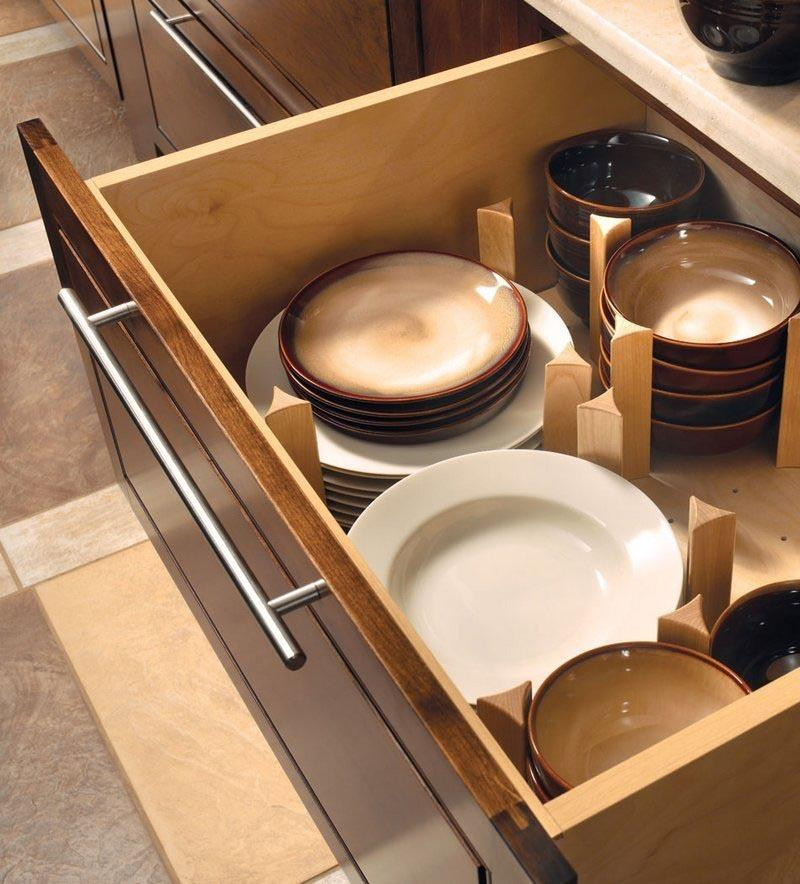
6. Pull-Out Filler:
– Features: Narrow pull-out cabinet or shelf designed to fit into tight spaces between appliances or cabinets.
– Benefits: Utilizes otherwise wasted space, provides additional storage for small items or pantry staples, enhances kitchen functionality.
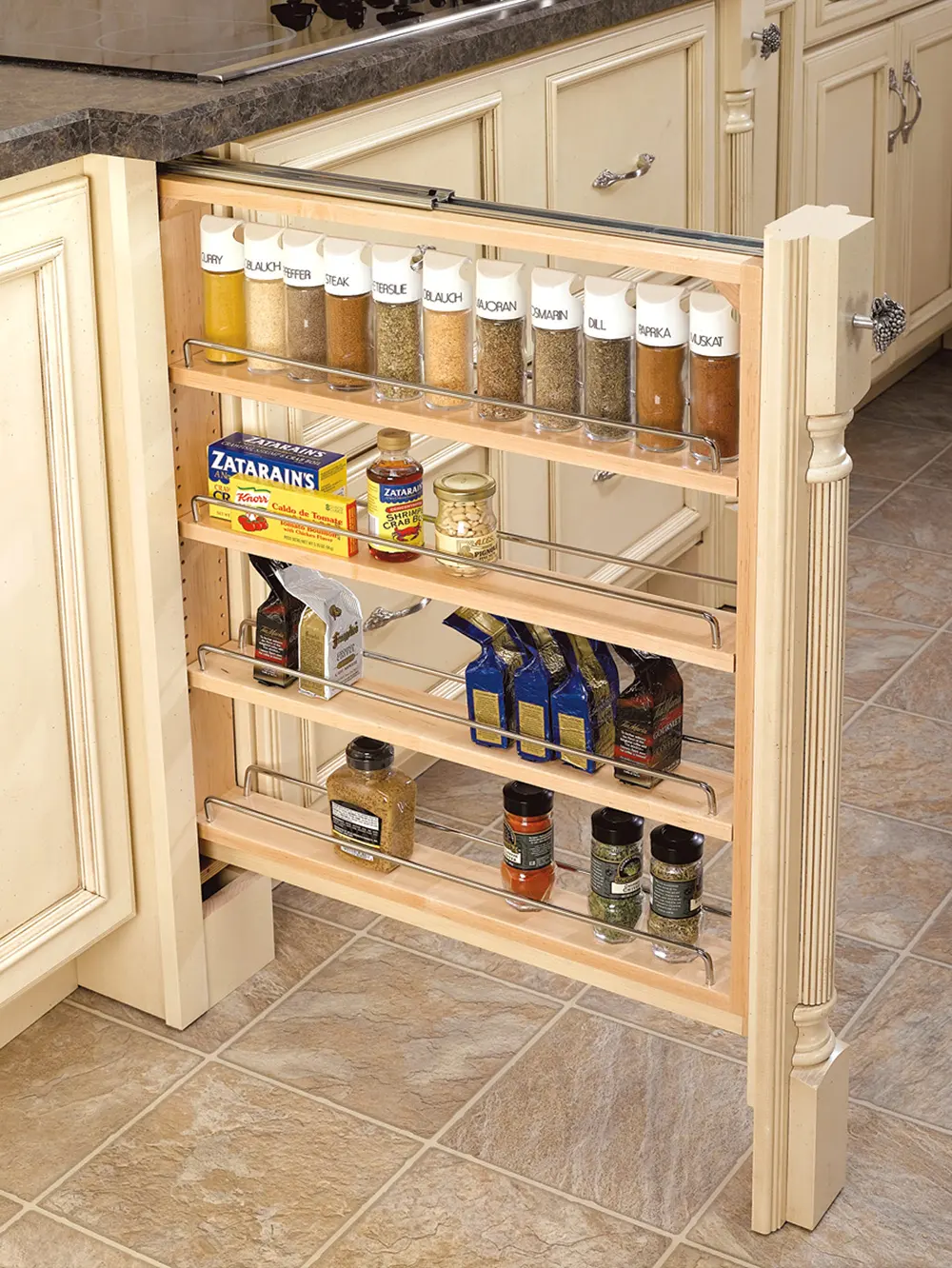
7. Blind Corner Swing-Out:
– Features: Pull-out shelves or baskets that swing out from blind corner cabinets for easy access to stored items.
– Benefits: Maximizes storage in hard-to-reach corner cabinets, improves accessibility and organization, reduces wasted space.

8. Trash Can Pull-Out:
Features: Sliding mechanism for concealing and accessing trash or recycling bins within a cabinet.
– Benefits: Keeps trash bins hidden from view, eliminates clutter on the kitchen floor, improves waste management efficiency.
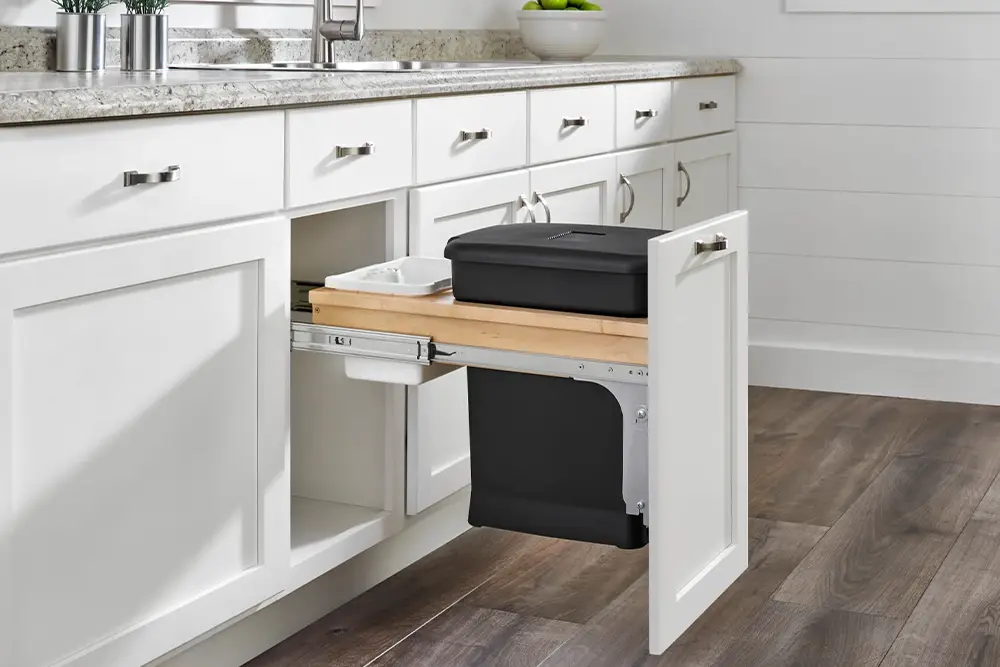
9. Pantry Organizer:
– Features: Shelving systems, baskets, and pull-out racks designed to maximize storage and organization in pantry cabinets.
– Benefits: Optimizes pantry space, facilitates efficient organization of food items, enhances accessibility and visibility of stored goods.
Consider your kitchen layout, storage needs, and workflow preferences when selecting the right accessories to optimize your kitchen space and functionality.
Consider your kitchen layout, storage needs, and workflow preferences when selecting the right accessories to optimize your kitchen space and functionality.

Kitchen flooring:
Solid Wood Flooring:
– Description: Solid wood flooring is crafted from a single piece of hardwood, like oak or cherry, providing a timeless, natural look with visible grain patterns.
– Advantages:
1-Timeless Beauty: Enhances any room with elegance and warmth.
2- Longevity: Can last for generations with proper care and can be refinished multiple times.
3- Value: Adds value to a home and is highly desirable to potential buyers.
4-Customization: Available in various wood species, plank widths, and finishes for personalized style.
– Considerations:
1- Susceptibility to Moisture**: Not suitable for high humidity areas like basements or bathrooms.
2- Cost: Typically, more expensive than engineered wood or laminate flooring.
3- Installation**: Requires professional expertise for proper installation.
In summary, solid wood flooring offers enduring beauty, longevity, and customization options, though it requires careful consideration of maintenance, moisture resistance, and installation costs for each unique space.
Engineered Wood Flooring:
– Description: Engineered wood flooring is made up of multiple layers of wood veneer, with a solid wood top layer. This construction adds stability and reduces the risk of warping or cupping, making it suitable for environments where solid hardwood may not be ideal, such as basements or areas with fluctuating humidity levels.
– Advantages:
1- Beauty: Like solid wood, engineered wood flooring offers the warmth and natural beauty of wood.
2- Stability: Its layered construction makes it more resistant to changes in temperature and humidity, reducing the risk of expansion and contraction.
3-Versatility: Available in various thicknesses, finishes, and wood species, providing options to suit different interior styles and preferences.
Laminate Flooring:
– Description: Laminate flooring consists of multiple layers, typically including a high-density fiberboard (HDF) core, a photographic layer that simulates the appearance of wood or stone, and a protective wear layer.
Advantages:
1-Affordability: Generally, less expensive than engineered wood or solid hardwood flooring.
2- Durability: Laminate flooring is highly resistant to scratches, stains, and wear and tear, making it suitable for high-traffic areas.
3- Easy Maintenance: The protective wear layer makes laminate flooring easy to clean and maintain. It doesn’t require refinishing like hardwood.
4- Versatility: Available in a wide range of designs, colors, and textures, allowing homeowners to achieve the look of natural wood or stone without the cost or maintenance requirements.
In summary, engineered wood flooring offers the aesthetic appeal of solid wood with added stability, while laminate flooring provides durability, affordability, and versatility in design options. Both options cater to different preferences and practical considerations, so it’s essential to consider factors like budget, maintenance requirements, and desired aesthetic when choosing between the two.
Vinyl Flooring Overview:
– Description: Vinyl flooring, primarily made from PVC, mimics natural materials like wood or stone in sheets, tiles, or planks.
– Advantages:
1- Affordability**: Cost-effective compared to hardwood or laminate.
2- Water Resistance**: Highly resistant to water, ideal for moisture-prone areas.
3- Durability**: Resistant to scratches, stains, and dents, suitable for high-traffic spaces.
4- Easy Maintenance**: Simple cleaning with regular sweeping and occasional mopping.
5- Comfort**: Some options offer added cushioning for a softer feel underfoot.
Considerations:
1- Environmental Impact**: Production and disposal may have environmental implications due to PVC.
2- Installation**: DIY-friendly options available, but professional installation may be needed for complex layouts.
3- Appearance**: While it can resemble natural materials, some may prefer the authenticity of genuine wood or stone.
– Variety: Available in diverse colors, patterns, and styles for different design preferences.
– Applications: Suitable for various rooms, including kitchens, bathrooms, basements, and commercial spaces.
In summary, vinyl flooring offers affordability, durability, and versatility, making it a practical choice for different spaces. However, considerations include environmental impact, installation complexity, and personal aesthetic preferences.
